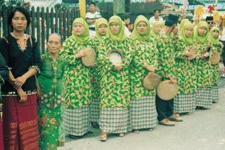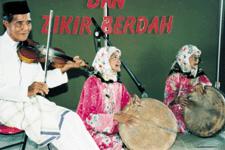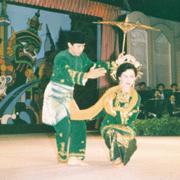The Malays of Sarawak
By Caroline A. Jackson

Malay women typically attired in baju kurung and headscarves. Photos:
Catharine Goh

A traditional sing-along accompanied by gendang and violin

The rich Malay culture is reflected in the joget dance
As elsewhere in Borneo, the Malays are the dominant ethnic group in
maritime Southeast Asia.
As the first Muslim converts in Southeast Asia, especially the Malay
archipelago, they have adopted the Islamic faith and so exclusively to be a Malay is to be
a Muslim.
It is no surprise that this seafaring people, which makes up 21 per cent of
the state's population of two million, have settled on the littorals and major rivers of
Sarawak.
The Malays in the riverside kampungs are predominantly fishermen while
those that have penetrated further inland are rice farmers.
Many, however, have migrated to the cities where they are heavily involved
in the public and private sectors and the professions.
Among the prominent Sarawak Malays are state Tourism Minister Datuk Sri
Abang Johari Tun Abang Openg, whose father was the first governor after independence, and
state Agriculture and Food Industries Minister Datuk Sri Adenan Satem.
Popular artistes like Camelia and Deja Moss are equally proud to their
Sarawak roots while even international singer Anita Sarawak can trace her ancestry to this
Bornean state in Malaysia.
With a complex and highly artistic culture. The Malays in Sarawak are
renowed for their beautifully crafted wooden houses, many of which can still be seen on
the banks of the Sarawak River in the capital city of Kuching and other nearby villages
such as at Kampung Bako, near the national park also famous for kain songket or cloth
woven with gold and silver thread and for their excellent silverware and brassware.
Malay literature plays an important role in life with the pantuns or
allegorial poems being popular with young and old alike.
Another popular feature is the traditional sing-alongs, usually by the
older folks, accompanied by the gendang or drums and the "joget" dance
especially during festivities, gatherings or other special events.
The embodiment of Malay culture, however is the kris, the superbly crafted
Malay dagger, which is often associated with magical powers.
In the olden times, a Malay man was not properly attired unless he was
wearing his kris and many men still wear them for ceremonial occasions and even at the
traditional wedding receptions.
The Sarawak Museum has a particularly fine collection of these highly
ornamental and very deadly weapons.
Source: Borneo Bulletin Sunday
Sarawak Tours
BACK
TO LEISURE PAGE
|
